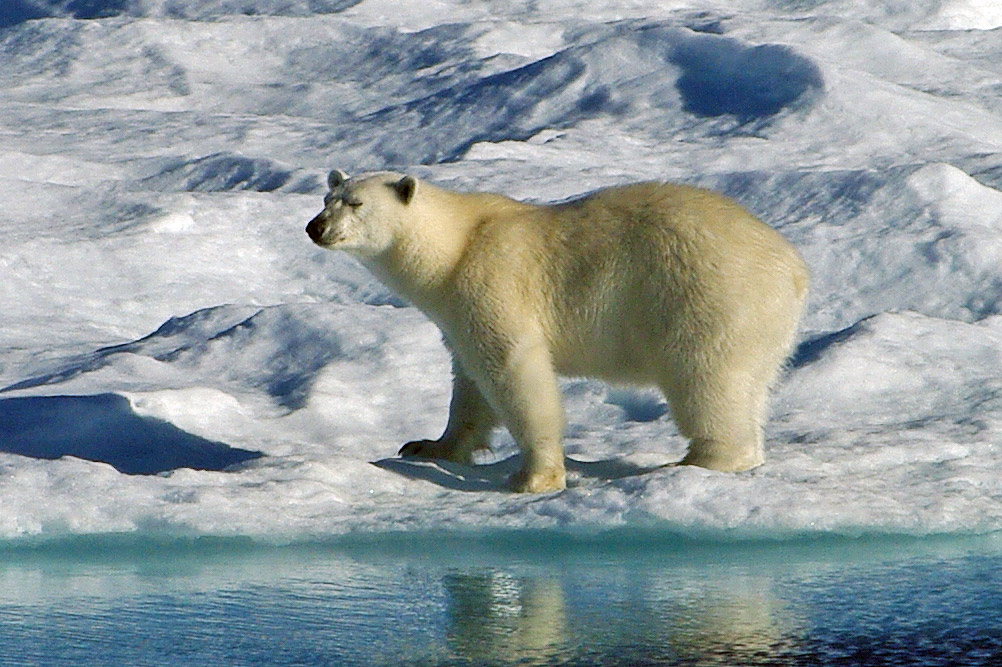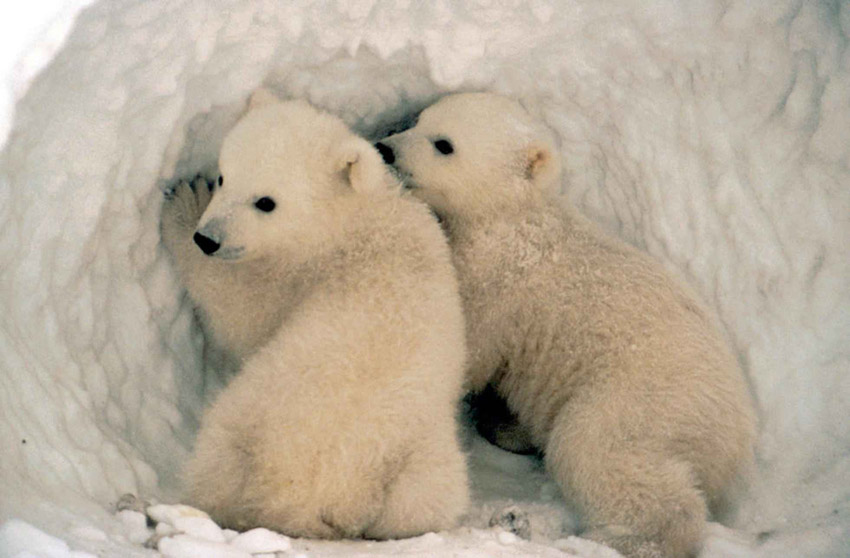Polar bears live and breed entirely in the far north they live their whole lives above the northern tree line in the Arctic. They feed mainly on seals and are regarded more as a marine mammal than a land mammal as they hunt largely at the edge of sea-ice.
Polar Bear - Facts and Adaptations
Ursus maritimus
Polar Bears are one of the archetypal polar animals associated with snow, ice and cold temperatures fending off the weather by being all wrapped up in a big fluffy thick white fur coat.
polar bear facts Basics
Average Weight: adult males 350 to 700kg
(770 - 1,540 lbs), adult females about half this weight.
Average Length: Length - 2.2 -
2.5m long (7.25 - 8 feet) including a very short tail of
7.5 - 12.5 cm (3 - 5 inches).
Breeding Season:
Pups born from November to February in a den in the depths
of winter. Usually two pups are born and weigh about 1kg
(2lbs.). The pups and mother survive on the mothers fat
reserves, the pups are about 15kg (35 lbs.) by the time
they emerge. Females breed around once every three years,
so in any given year there are three times more breeding
males than females.
Estimated world population:
- 20,000 to 25,000
Diet and Feeding:
The main and preferred food of polar bears is seals which
are caught out on the sea-ice. As adults they mostly eat
the blubber, but will also eat the meat for protein while
still growing. Beyond this, they are opportunist carnivores
though will resort to berries, roots or sea-weed if there
really is nothing else.
Conservation status:
Vulnerable
Distribution:
Circumpolar around the Arctic mainly within the Arctic Circle.
There are 19 recognised sub-populations.
Predators: None other than man.
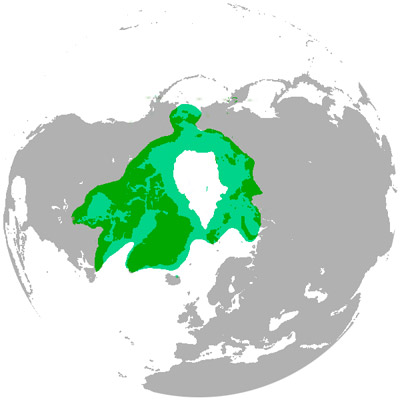
Distribution range of polar bears
What are Polar Bears Foxes like? how do they survive?
Lets get the obvious stuff out of the way first. Polar bears live in the Arctic around the North pole and penguins live in the Antarctic around the South pole.

Polar Bear - North

Penguin - South
Polar bears and penguins never meet
Polar bears live and breed entirely in the far north they live their whole lives above the northern tree line in the Arctic. They feed mainly on seals and are regarded more as a marine mammal than a land mammal as they hunt largely at the edge of sea-ice where wind, currents and tides provide open areas of the sea, so attracting their prey. Some populations retreat south when the winter sea-ice breaks up spending the summer months on land while others retreat north following the ice edge.
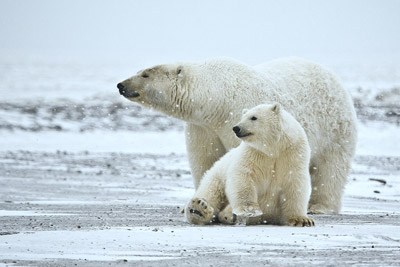
Polar bears are the world's largest land predator with only the Kodiak bear (a subspecies of brown bears) coming near to the same size. Polar bears are dangerous to humans and there have been a number of fatal attacks, though such attacks are quite rare as polar bears live in remote isolated regions where they don't often come into contact with people. The relatively few people who do live or visit where polar bears are found are usually well aware of the possibility of encounters and know how to deal with it.
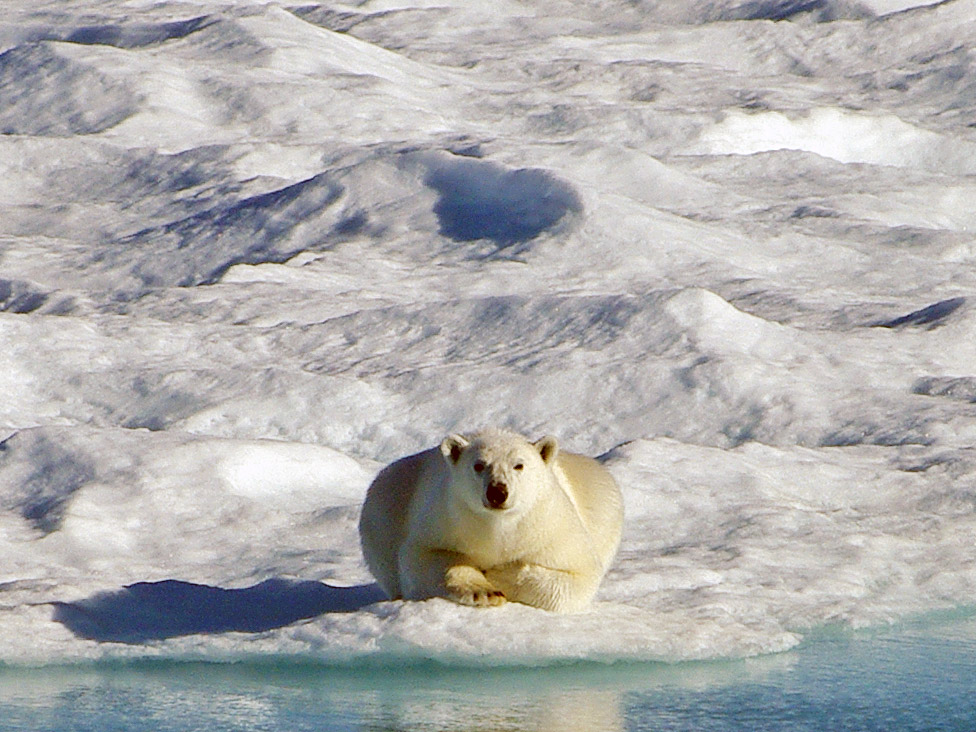
Polar Bear Adaptations:
- Low surface area to volume ratio (anatomical)
- Compared to other species of bears, polar bears have small
extremities, proportionally shorter legs and a stockier
build. This reduces the surface area to lose heat from.
This is a common characteristic amongst animals that live
in cold environments that enables them to retain their heat
and conversely means they often can't cope with warm
temperatures as they easily overheat in warmer temperatures.
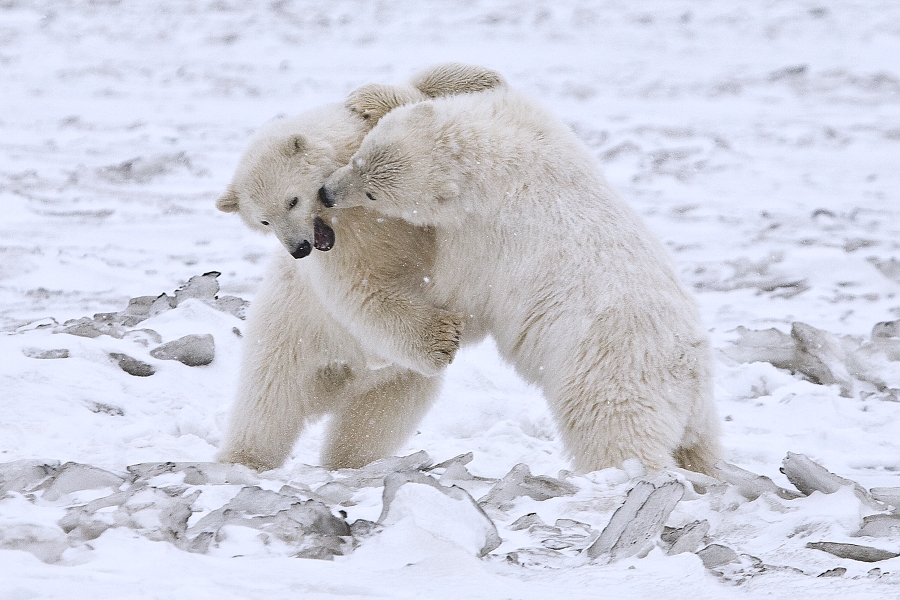
- Small extremities to reduce heat loss
(anatomical) - Polar bears have small ears covered in thick
fur, a very short tail and a relatively short and squat
muzzle, all of which help to retain heat.
- Polar bears eat a very high fat diet and have
adaptations to allow them to process this food
(physiological) - *This
is possibly the key adaptation that polar bears have*.
It enables them to eat the blubber of the seals that they
catch which is the most energy rich and abundant part of
the seal. Other animals could simply not survive if they
ate so much fat in their diet. Adult bears often only eat
the blubber while younger still growing bears will also
eat the meat for protein.
Eating fat and not protein has another benefit in that it means the bear doesn't have to excrete excess nitrogen from the protein which being a mammal would be in the form of urea in the urine. Excreting urea requires an amount of water to be lost, while the bear could eat snow to replace this, it would use a significant amount of energy to warm the bear back up again, consuming fat simply avoids the problem. - Thick layer of body fat / blubber (anatomical
/ physiological) - This can be up 10cm (4 inches) thick,
it is used both for insulation and also for food storage
to help survive when food supply may be intermittent especially
in the summer months when bears often go hungry for long
periods due to not being able to hunt their preferred food
of seals. Up to 50% of a polar bears' weight can be
fat! It also helps them to float naturally when swimming
so avoiding having to use energy to keep their head out
of the water.
- Processing body fat to gain metabolic water
(physiological) - Polar bears store a lot of fat which they
use for energy in the process combining it with oxygen to
release carbon dioxide and metabolic water. They live in
a polar desert with little access to fresh water especially
in the colder months (which are in the majority) in this
way they can get extra fresh water - camels do a similar
thing with their stored fat.
- Thick camouflaged fur (anatomical)
- The coat of the polar bear is especially thick and luxurious
being the thickest of any bear (unsurprisingly!). There
are two kinds of hairs, short soft dense inner hairs and
longer stiffer outer guard hairs. The coat is the same colour
all year round unlike some arctic animals which have a darker
coat in the summer months. The coat usually appears to be
perfectly white, though has a pale yellow tinge to it which
becomes more pronounced in older animals. The colour of
course provides camouflage against an icy and snowy background.
- Thick fur on the paws (anatomical)
- to insulate them from snow and ice and also provide for
grip on slippery surfaces. The paws are large in size to
help spread the bears weight over ice and snow and have
blubber under the pads for extra insulation.
- Maternity dens are dug into snowdrifts by pregnant
females, these can have one to three chambers and provide
protection from the cold and winds (behavioral)
- The females give birth in the winter in these dens, twins
are most common, the cubs stay with their mothers for over
two years, around 28 months. The males have no part to play
in the raising of the cubs leaving the females shortly after
mating.
- Pregnant females go into a kind of hibernation
in their maternity den during the winter in which they give
birth. (behavioural / physiological) - Males and
non-pregnant females don't make dens and don't hibernate.
- Polar bears are very strong swimmers
(anatomical/behavioural/physiological) - They have
been found in open waters 200 miles (320 km) from land and
will readily swim long distances if necessary, though it
is energetically expensive and young bears avoid swimming
very far. They swim using their front legs in a manner where
they reach out with the leg and pull at the water with their
large paws, the back legs generally trail behind.
- Polar bear liver contains a toxic amount of
vitamin A that can cause severe illness or even death if
eaten. This is not actually an adaptation admittedly
but is interesting nonetheless. Husky dog liver is similar
though not quite as toxic. So if you are ever starving in
the Arctic and manage to kill a polar bear or husky, leave
its liver well alone and go for the chitterlings instead.
Polar Bear Evolution
Polar bears evolved from brown bears, they are very similar in many ways and can even occasionally interbreed on the extreme edges of their respective ranges giving rise to fertile offspring.
Recent studies on the genetics of polar bears have shown that they split from brown bears between 343,000 and 479,000 years ago, much less than previous estimates that went up to 5 million years.
This is a very short time period in evolutionary terms and required major physiological changes to allow polar bears to survive on a very high fat seal-blubber diet switching from the mainly vegetarian diet of the brown bear.
While white fur, small ears and large paws are the most obvious adaptations, it is the physiological adaptations of dealing with the processing of fat so as not to lead to heart disease that are the most important. Most other mammals would not be able to survive on the high fat diet that polar bears eat.
One of the most important genes in the speciation of polar bears has been one known as APOB, this makes a protein which is part of s molecule called Low Density Lipoprotein (LDL), a large molecule made of a protein and lipid (fat) commonly known as "bad" cholesterol. The APOB gene protein is important to the process of transporting lipids (fats) in the blood and in the uptake by body cells and in the formation of fatty plaques in arteries that can lead to cardiovascular disease, blood clots and heart attacks. The AOB gene helps to remove LDL from the bloodstream dumping it into fat cells. In a sense polar bears have an anti-junk-food gene which allows them to survive on a diet that would kill most mammals.
What do Polar Bears eat?
-
The commonest and preferred food of Polar bears are seals, mainly ringed and bearded seals which live all around the Arctic in large numbers. They are caught when they come to the surface to take a breath at their breathing hole or if they are caught having hauled out of the sea resting on the ice. Seal pups are vulnerable when they are left by their mothers in a cave-like structure between the breathing hole and the surface snow/ice.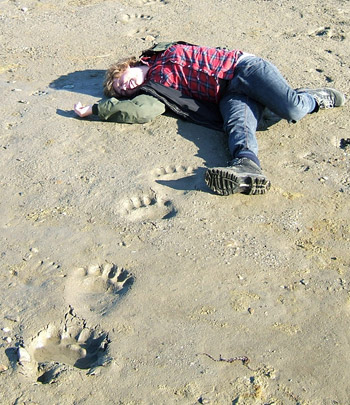
Polar bears can be dangerous to people (don't worry he's ok, the bear walked by hours beforehand), but look at the size of those paw prints!
- Polar bears hunt seals when they are at the
sea/ice/air interface, they very rarely catch them
on land or in the open water, despite polar bears being
strong swimmers, they are no match for the speed and agility
of a seal in the water.
- Larger prey such as walrus may be attempted
but they are large and powerful with long dangerous
tusks so a polar bear has to be desperate and hungry to
try to kill one.
- Polar bears will attempt to catch land prey
such as caribou / reindeer and even musk oxen,
polar bears rapidly overheat on land in a prolonged chase
and are usually outrun, they do have a very rapid burst
of speed over a short distance however.
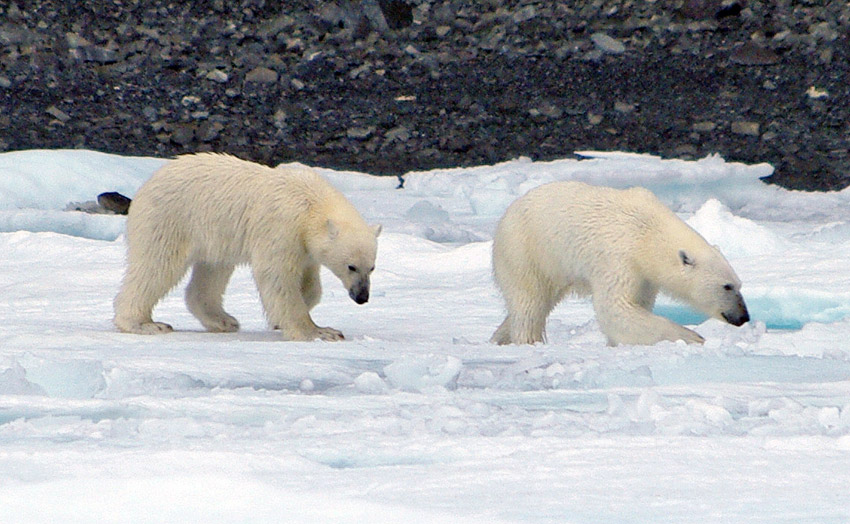
A pair of young polar
bears. probably about two years old having recently left their
mother
- Polar bears have been seen hunting small whales
such as beluga and narwhals sitting by the side
of a breathing hole waiting for them to surface. Usually
this is not possible and the whales will simply avoid the
bears. In the winter months though, whales may become trapped
in a decreasing expanse of open water called a polynya forcing
the whales into range of bears.
- Smaller prey such as birds, especially when
nesting along with chicks and eggs will be taken
where possible and if the bear can climb to reach the nest
site.
- Plant foods such as berries, roots and some sea-weeds may be eaten in the summer months, polar bears are the most carnivorous of all bears and these are only eaten when nothing else is available.
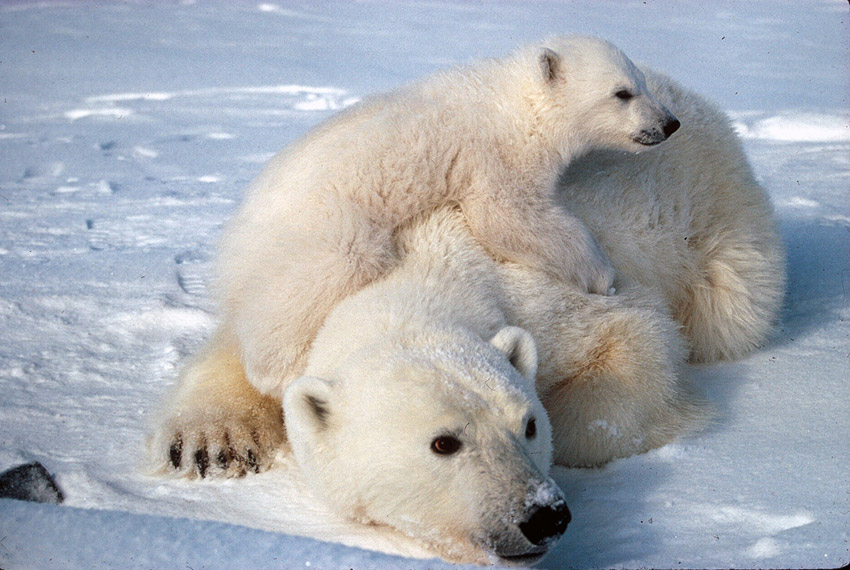
Mother polar bear
and young cub, mothers show great affection and tenderness to
their young
Why did brown bears evolve into polar bears - cartoon
Picture use:
Creative Commons Attribution 3.0 license - two bears play fighting
and mother and cub looking to the left - Alan D. Wilson

